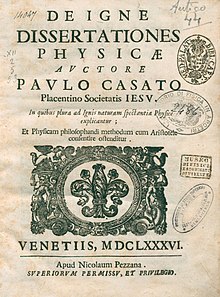Paolo Casati
| Part of a series on the |
| Society of Jesus |
|---|
 |
| History |
| Hierarchy |
| Spirituality |
| Works |
| Notable Jesuits |
|
|
Paolo Casati (in Latin, Paulus Casatus) (1617 – 22 December 1707) was an Italian Jesuit mathematician. Born in Piacenza to a Milanese family, he joined the Jesuits in 1634. After completing his mathematical and theological studies, he moved to Rome, where he assumed the position of professor at the Collegio Romano. He was given the chair in mathematics after teaching philosophy and theology.

Casati in Sweden[]
In 1651, Casati was sent on a mission to Stockholm in order to gauge the sincerity of Christina of Sweden's intention to become Catholic. He subsequently returned to his post at Rome. In 1677, he moved to the Jesuit College in Parma, where he remained until his death.
Casati's Terra machinis mota[]
The astronomical work Terra machinis mota (1658) imagines a dialogue between Galileo, Paul Guldin, and Marin Mersenne on various intellectual problems of cosmology, geography, astronomy and geodesy. For example, they discuss how to determine the Earth's dimensions, floating bodies, the phenomena of capillarity, and also describe the experiment on the vacuum made by Otto von Guericke in 1654. The work is remarkable for the fact that it represents Galileo in a positive light, in a Jesuit work, only 25 years after Galileo's condemnation by the Church.
Casati and Theories on the Vacuum[]
Casati discussed the hypothesis of horror vacui, that nature abhors a vacuum, in his thesis Vacuum proscriptum, published in Genoa in 1649. Casati confuted the existence of both vacuum and atmospheric pressure, but he did not rely entirely on scientific observation, and refers to Catholic thought in order to back his claims. The absence of anything implied the absence of God, and hearkened back to the void prior to the story of creation in the book of Genesis (see Vacuum: historical interpretation).
Named after Casati[]
The crater Casatus on the Moon is named after him.
Other works[]
- Fabrica et uso del compasso di proportione (1664), a work explaining the construction and use of proportional compasses
- Le ceneri dell'Olimpo ventilate (1673), a dialogue about meteorology
- De gli horologi solari (unpublished manuscript): about sundial construction
- De igne (in Latin). Venezia: Nicolò Pezzana. 1686.
- Exercitationes matheseos candidatis exhibitaæ (1698) (unpublished manuscript): a collection of algebraic and geometrical subjects.
See also[]
- List of Jesuit scientists
- List of Roman Catholic scientist-clerics
Sources[]
- 17th-century Italian mathematicians
- 18th-century Italian mathematicians
- 17th-century Italian physicists
- 17th-century Italian Jesuits
- 1617 births
- 1707 deaths
- Jesuit scientists
